Christopher Ian Thoma's Blog, page 44
December 17, 2015
Review – Monkey Shoulder, Batch 27, Blended Scotch Whisky, (No Age Statement), 43%
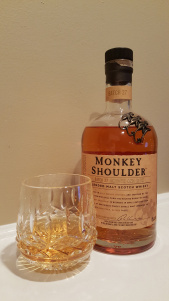 I don’t subscribe to the theory of evolution. You will never convince me that we are descendants of primates.
I don’t subscribe to the theory of evolution. You will never convince me that we are descendants of primates.
You are probably not surprised by this.
I should say that I am willing to consider that mankind may very well be devolving into apes. Just look around. The evidence is certainly accumulating.
It probably won’t surprise you that I don’t subscribe to the philosophy that if you put a million monkeys in front of keyboards, one will eventually produce the works of Shakespeare. That will never happen. Although, I am convinced that the proposition isn’t necessarily far-fetched. In fact, I think that it is very likely that in some super-secret laboratory hidden deep below the earth’s crust, our Federal government has already tried this experiment. The result: All six volumes – 11,700 pages – of the IRS tax code. That thing could be nothing less than the result of a massive room filled with monkeys pounding on keyboards and throwing feces.
Speaking of formulating monkeys and feces, the Monkey Shoulder (batch 27) is by no means relatable. It’s pretty good.
When I’m dealing with a blend (which I seem to be doing more and more these days), I find that I’m rarely interested in chasing after the information which would reveal to me the source malts. I’m just not that concerned in knowing what they used. In my opinion, once the malts have been brought together, bottled, and presented as a singular beverage, the merit of the common union, the final product, is what matters most.
But with this whisky, with the first sip, I became somewhat suspicious. “I know these Speyside whiskies,” I thought. And sure enough, after a few clicks of the mouse, I discovered that I was right, at least mostly. This blend is a combination of The Balvenie, one of my absolute favorite whiskies; Kininvie, which I’ve not yet tried; and Glenfiddich, which pretty much everyone has tried.
Now I mentioned before that this whisky is pretty good – not exceptional – but pretty good. The only thing I can think is that the folks at Monkey Shoulder acquired some orphan malts that the individual distilleries noted above didn’t intend to bottle and sell as their own.
The nose is almost a “warm climate” merlot, which I did not necessarily like but I did find interesting because of the distinct and hovering black cherry perfume. It certainly promises something sweet.
The palate throws up signposts that The Balvenie is doing the heavy lifting. There is a general lightness to the initial greeting, nothing imposing, followed by a brushing with the autograph honey and a touch of vanilla. The Glenfiddich and the Kininvie arrive with a wink of malt and some earthiness to give it tone.
The finish is short. It’s there and then it’s gone, like any sensibility in that underground bunker housing the mandrill IRS think tank.


December 13, 2015
Review – Four Roses Single Barrel – Private Selection, Barrel Strength, 60.2%
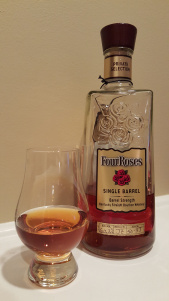 There’s a particular little dispute within the clergy ranks that has me quite amused. I only run into it every now and then, but each time I do, it almost always causes me to pause, draw a breath, and sigh to myself, “You know, who cares?”
There’s a particular little dispute within the clergy ranks that has me quite amused. I only run into it every now and then, but each time I do, it almost always causes me to pause, draw a breath, and sigh to myself, “You know, who cares?”
The hullabaloo has to do with whether or not one says “John the Baptist” or “John the Baptizer.”
Yeah, pretty stupid, right?
I think that most folks probably say “John the Baptist.” That’s what I say. But then along comes another pastor to what would be an otherwise pleasant conversation who says, “You mean, John the Baptizer, right?”
“Um, no. I mean John the Baptist.”
“Well, that’s not his proper title in the Scriptures.”
It is at this point that I am sometimes tempted to steal from Jesus and say something like, “You are in error because you do not know the scriptures or the power of God” (Matthew 22:29). But most often what comes out is, “Were you saying something? I’m hearing sounds coming out of your mouth, but I can’t quite make what you’re saying.”
And honestly, while I’ve heard both sides of the argument, in the end I really can’t side with one or the other because neither’s proofs are more convincing than the other, let alone actually Biblical. Most are circumstantial. What I can do is tell you that when you do finally engage with the Bible objectively on the subject, the Bible ends up pausing, drawing a breath, and sighing to itself, “You know, who cares?”
There are plenty of places to go in the New Testament in order to consider the subject, but to save time, a good place to visit is in Mark 6:24-25. The whole argument is sort of consolidated there. Essentially, King Herod is so impressed by the dancing of Herodias’ daughter Salome, he offers to give her anything she wants. Well, Salome runs out and asks her mother what she should ask for. Herodias counsels that she should ask for “τὴν κεφαλὴν Ἰωάννου τοῦ βαπτίζοντος,” that is, the head of John the Baptizer. And that’s what Salome does; except for one minor detail. Standing before Herod, the request is made for the head of “Ἰωάννου τοῦ βαπτιστοῦ,” or, John the Baptist.
So which is it, then? The point is that both titles were interchangeable. Although, I’ll bet the first note of concern I’ll receive from any one of my “Baptizer” clergy friends who reads my whisky reviews will be something like, “Well, that Salome girl, she was an ignorant child and didn’t use the correct expression.” Again, to that, I humbly offer, “Were you saying something? I’m hearing sounds coming out of your mouth, but I can’t quite make what you’re saying.”
Who cares?
You are probably wondering what all this has to do with the Four Roses Private Selection Barrel Strength Kentucky Straight Whiskey. The connection is two-fold.
The first is that there is one friend in particular who will argue the necessity of discerning the centrifugally earthshattering concerns being thrown out and around the Baptizer/Baptist controversy, and yet will so crassly say that Bourbon and Scotch are essentially the same drink, just from different regions of the sphere. Now, that’s a duel I’ll accept. Scotch and Bourbon are absolutely nothing alike, and to be quite honest, I am beginning to fear that the differences are indeed so great, and one is so much more wonderful, that I’m really only fooling myself as I attempt to chart a Bourbon course.
The second is that my agent suggested that certain publishing houses were surprised that I didn’t spend as much time talking theology as they expected. But of course, I talk quite a bit of theology throughout Angelsportion, but it is rarely an “in your face” event. It is meant to be subtle, unlike this bottle of Four Roses. This is about as “in your face” as it gets when it comes to any Bourbon I’ve ever tried. And with that, everything that I struggle to enjoy in Bourbon is amplified, making this a thoroughly unenjoyable beverage and making my journey more complicated.
Being that it is essentially a cask strength edition (which when it comes to Scotch I just love), everything in the barrel that brings about the whiskey’s sour nature seems to be plugged in and turned up to 11.
To start, the nose is so tempestuously angry that I can barely sense what I think they want the discerning consumer to smell. And that’s too bad because there seems to be the promise of honey crisp apples in there somewhere – sweet, but thinned – and all but bygone due to a rage filled and overpowering smell of alcohol. There are very few Scotch whiskies that smell like this, and the ones that do, you can buy by the gallon.
The palate is incredibly warm, but just when you think there is still time for this whiskey to fluff your pillow and tuck you in for a pleasant bit of respite, it puts the pillow over your face and tries to smother you. I’ll admit that the death would come with a kiss of chocolate, a touch of honey, and a turn of tannin, but there’s also a piercing sourness in that pillow, suggesting it hasn’t been washed in over a year. Ultimately, there aren’t enough of the pleasantries to convince you that it was a blessed death.
The finish removes the sour and then dangles the pleasantries before you one more time, almost as if the whiskey is saying in a Gollum-like voice, “Give us another go, my precious. You missed some things. Come back. Come back to us.”
Don’t do it. Instead, look that bottle straight in the eye and say, “Were you saying something? I’m hearing sounds coming out of your mouth, but I can’t quite make what you’re saying.” And then go grab a bottle of Scotch to counteract the temptation. Any Balvenie, Glendronach, or Laphroaig will do.
+++By the way, feel free to recommend something, anything, to convince me to continue trying.


December 7, 2015
Review – Jura, Diurachs’ Own, 16 Years Old, 43%
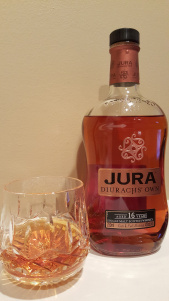 Evelyn was clearly enjoying the song, but was also in complete disagreement with the supposed lyrics.
Evelyn was clearly enjoying the song, but was also in complete disagreement with the supposed lyrics.
“You like this song, don’t you, honey?” I asked catching her eyes in the readjusted rear view mirror.
“Yeah,” she said and bobbed her head back and forth to the rhythm. “But I don’t think I would stay awake for broccoli.”
“Yeah, me either,” I said muffling my amusement. “But I might stay awake for pizza. Or a a grilled steak.”
“They’re not saying ‘broccoli,’ Evelyn,” Harry reproved. “Their saying ‘Brooklyn.’”
Awe, man. You ruined it. She would have given me more, for sure.
Oh, well. Can you guess the song?
Yep. Evelyn was bopping along to the moniker 80s guitar riff wrapped in a vivacious drum track accompanied by the Beastie Boys shouting: “No… sleep… till Broccoli!”
Close. Not right, but very close, and still a lot of fun.
Now, as this little yarn relates to the Jura 16-year-old “Diurachs’ Own” edition, you may assume that I liked it. It’s just that something was a little off.
When you carry this edition to your nose and give the whisky a swirl, there is the kindly introduction to a sweetened orange juice and malt invention. Very inviting, to be sure. You’re intrigued.
But then you bring the glass’ jig to a pause and swipe a careful sum and the lyrics slip just a little. The malt is there, and it’s quite nice. There’s also a little bit of something chocolaty. That is very nice, too. But in the midst of these agreeable verses is a slight bitterness suggesting that something was not quite right with the orange juice mix. The sugar is there in the beat, but it sure seems like someone swapped out a portion and used brown sugar instead. It remains catchy, very sweet, but because of this it gets a little out of step with what seems to be a warmer intention. Maybe the better way to explain it would be to remind you of the time when you were a kid and you took it upon yourself to make a refreshing jug of Kool Aid for the family but you couldn’t find the regular sugar so you improvised and used a strange blend of powdered and brown sugar instead. Remember when you did that? For a kid, the final product was just like drinking a glass of cotton candy flavoring. It was heavenly. But then your mom came along and took a sip and burst her heart. Had you used the right ingredients, the beverage would have been balanced and mom would still be with us. Poor kid. The guilt must be terrible.
Anyway, the short-to-medium finish is delightful. In fact, it saves the day. The “off-ness” loses its intensity quickly, being overtaken by a finishing honey.
Like I said, it wasn’t bad, just a little off. Rest assured that you can drink this stuff and be happy much in the same way you can crank the music in the minivan and sing “No sleep till broccoli!” without missing a beat.


December 5, 2015
Review – Ballantine’s, 17 Years Old, 40%
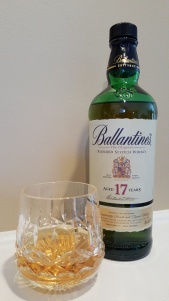 In my review praising the Ballantine’s 21-year-old edition, I was a bit rough on its sister edition, the Ballantine’s Finest. But you’ll note that I mentioned I have a soft spot for Ballantine’s, which is how the Finest ended up in my hands in the first place. I took a chance.
In my review praising the Ballantine’s 21-year-old edition, I was a bit rough on its sister edition, the Ballantine’s Finest. But you’ll note that I mentioned I have a soft spot for Ballantine’s, which is how the Finest ended up in my hands in the first place. I took a chance.
What I do not have a soft spot for is grammatical carelessness. (For a fuller rendition of my concerns, take a look at my review of the Dalwhinnie Distiller’s Edition. You’ll see that it’s not snobbery. It’s the need to maintain precision in communication. Words are very important, most especially to a preacher.)
I’m not saying I’m perfect. Any editor could scan my stuff and find plenty of mistakes, I’m sure. And I’m not saying I don’t appreciate colloquial styled speech. You’ll certainly find a lot of it my writings. What bothers me the most, I guess, is the careless usage of the easier stuff; things like homophones. I’m bothered by the mismanagement of words that sound the same but have different spellings and meanings.
Now, I know that sometimes people are just typing so quickly and the well-intentioned but often troublesome spellchecker catches a word and inserts the wrong one for them. I’ve experienced such travesties, and I know people who are more than aware of the proper usage for words like “there,” “their,” and “they’re” who find themselves being unfairly framed by the machines that tend to rule our lives.
However, I also know that the people who don’t know the difference and continue to assault the folks around them with these mistakes won’t change their evil ways until you tell them, and perhaps it is the easily stirred post-modern rage at being corrected that dissuades most of us from the conversation and perpetuates the problem. Admittedly, I have that same fear. I often just don’t have the energy for it, anyway, and so I’ll bite my tongue.
But sometimes – sometimes – I am tempted to contest the perpetrator, and I imagine beholding it unfold something like this…
+++++++++++
“Thanks so much for sending that short story. It was an inspiring read.”
——–“Your welcome. Ttyl.”
“What?”
——–“Your welcome.”
“What?”
———“Are my texts not getting thru? Did you get this one?”
“Yes, I’m getting your texts, I just didn’t understand your response.”
———“What?”
“That’s what I asked.”
———“I know. I said your welcome.”
“My welcome?”
———“What do you mean my welcome?”
“That’s what I’m asking you.”
———“You said thank you. I said your welcome.”
“My welcome?”
———“I don’t understand.”
“Neither do I.”
———“You don’t understand the answer to thank you?”
“I don’t understand why you are answering my thanks by referring to a welcome in my possession. I don’t own any welcomes.”
———“What are you talking about?”
“Okay, how about this… Got a minute more to talk about that story you sent?”
———“Um, sure.”
“I thought it strange that the guy righting the article, who is also the mane character, couldn’t fined the waitress who build him after the meal. She was so kind even in her struggles, and he wanted to prey for her, but he missed the opportunity. I guess that it was knot to be. But hey, who nose? Maybe there’s a chants that he’ll sea her sometime in the future. It makes cents that he will because she works their and he visits every morning to eat his hot serial and drink his tee. What do you think? Do you think this tail between the too is unfinished? Weather or not it is, weed better call this discussion to an end. It is late and it is thyme for bed.”
“Hello?”
———-“You’re welcome.”
+++++++++++
After such a taxation to heart, soul, and mind, it’s good to have a nice Scotch whisky waiting in the wings to receive you. Of course there are some that bear a resemblance to the carelessness that evoked the above response. And I won’t mislead you. As I noted in the introduction, you do well to steer clear of certain Ballantine’s editions because it is possible to experience unconcerned craftsmanship. But the 17-year-old blend isn’t necessarily in that class.
This one is well-enough scribed and sufficiently edited for at least a modest communication and basic coherency. That being said…
It isn’t the nose that made this whisky, at least it wasn’t for me. There’s a summery lightness about it, although in that same gentleness is the suggestion of too little malt amidst sun-ripened fruit that may have been left out a little too long.
It’s the palate and finish that reach to you and convince you to stay.
The palate is the sweeter homily, delivering more a little Gospel than Law. The sugared grains are unmistakable and swirling in a thinned, cool berry sauce. The finish is short, trickling through and leaving only a slight mention of the whisky’s sweeter darlings.
Nice, and yet I wouldn’t prefer it to the 21-year-old edition. Although, I would say that the Ballantine’s 17-year-old could be a worthy offering to the possibly-offended texting partner noted above. Pour a generous helping of this in his or her glass, and go for it. My bet – offering a kindly swig might might be settling enough to the spirit to allow for you to say whatever you want to them. Give it a try.
If you try it, send me a note afterward and let me know how it went – that is, if you still have all of your teeth.


December 3, 2015
Review – Crown Royal, Northern Harvest Rye, (No Age Stated), 45%
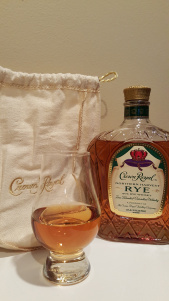 I have here before me Jim Murray’s “Whisky of the Year” selection for 2016 – the Crown Royal Northern Harvest Rye.
I have here before me Jim Murray’s “Whisky of the Year” selection for 2016 – the Crown Royal Northern Harvest Rye.
Allow me a moment to ruminate.
Have you ever used a single-occupancy public bathroom? If not, most likely you at least know what I am talking about. Essentially, they are equipped with a sink, toilet, an overflowing can of garbage, and a locking mechanism on the door.
The lock is very important. Some bathroom locks are latches. Some are switches. Some are push-buttons. Some are unseen, that is, they require a push and slight twist of the whole doorknob to bar prowlers. There are lots of locks. All are designed differently. However, the purposes of the various locks are the same. Not only do bathroom locks serve to prevent unwanted intruders during one of the most sacred moments of your daily routine, but their very presence helps to preserve peace of mind. They establish a rampart of trust and bring a measure of tranquility even while the task is in mid-throe.
But have you ever tested the lock before getting down to business? I’m sure you engage the lock, but do you check to see if it actually works reliably? I do. It doesn’t matter if the restroom is commercial or residential, with the door open, I always engage the lock and test it from the outside to make sure that the knob is immovable and sturdy. Then I close the door, engage the lock again and pull on the door to make sure that all of the necessary door components are aligned accordingly.
This may sound somewhat obsessive, but it only took one lock failure to breach my trust.
In a way, Mr. Murray is a lock. Many trust him. Many rely upon him to preserve them from unwanted trespassers to the sanctity of their whisky cabinets. Many heed his sturdy experience and give uninhibited credence to his long-secure recommendations. Many will run right out and purchase the Crown Royal Northern Harvest Rye and come to the shocking realization that the lock malfunctioned.
There is nothing deeply wonderful about this whisky. At all. There is nothing to suggest that it deserves the prestigious enthronement as 2016’s “Whisky of the Year.” And to see that it bears such a prized circlet, quite frankly, has me baffled.
There is no complexity in the nosing. It is a wafting of red licorice and what seems to be something like cheap gin. To wit, it’s piney, and admittedly in a delightful Bombay Sapphire kind of way rather than a bottom shelf Gordon’s. Still, the nipping alcohol is most definitely a noticeable part of the bouquet and it dodders near the level of bothersome.
The Palate is going to surprise you. Well no, actually, it won’t. It’s red licorice again. But at least the gin is more or less gone. Unfortunately, it is replaced by too little of the rye you were hoping for and too much of what seemed like a stranger mint. Very weird and not all that composed or stable.
The finish is medium, gradually departing by way of the sensation that you’ve been chewing a piece of original flavored Bazooka Joe bubble gum barely dotted with a drop of pure alcohol.
For the sake of all those innocent folks who didn’t know that their trusty lock was failing and they ran right out to boost Diageo’s profits, I’m glad you can get this edition for about $35.
But honestly, you’d be better served by something like Cutty Sark. Or in other words, at least put the overflowing garbage can against the door so that you can prop your foot against something to help hold the door in place. It’s not the best, but it works. And it’s better than suffering the embarrassing consequences of trusting in a faulty lock.


December 1, 2015
Review – Remy Martin, Louis XIII Cognac, 40%
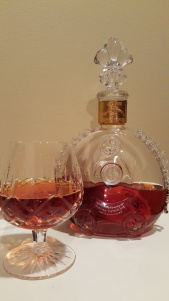 Don’t ask me how I came to possess this unattainable bottle in my lowly estate. Let’s just say that when you write a whisky blog that makes people laugh on occasion, accomplish successful valuations of antique editions for world travelers, and even find yourself crossing paths with the owner of the only vodka company in Lithuania, weird things happen.
Don’t ask me how I came to possess this unattainable bottle in my lowly estate. Let’s just say that when you write a whisky blog that makes people laugh on occasion, accomplish successful valuations of antique editions for world travelers, and even find yourself crossing paths with the owner of the only vodka company in Lithuania, weird things happen.
God has been good to me in this regard.
If you look online you’ll see that the Remy Martin Louis XIII Cognac is being sold for anywhere between $2,500 and $3,500, depending upon the part of the globe you occupy. It just so happens that my location here in time and space has seen to me being gifted a half full bottle (I’m forever an optimist) that was first opened many years ago. The giver did not share the exact date, only that it was purchased in the early 90s and enjoyed in the company of a close friend following a significant courtroom victory.
As I understand, the Louis XIII is a blend of over a thousand differed cognacs, all of which have been aged between 20 and 100 years. It’s presented in a crystal baccarat with a 22 karat gold neck wrap. The bottle alone is being sold online these days for a pretty penny, although the edition before me has a slight crack and two of the side petals appear to have small portions chipped off. This bottle has been jostled over the years, I’m guessing. Still, it’s a pretty incredible edition to behold.
Of course, there is a problem, right? Scotch is my thing. Cognac is not.
Oh, what to do, what to do? Well, just know that I’m not stupid, and you are going to read the first cognac review Angelsportion has ever produced.
The first thing I noticed about the beverage is that it coated the side of my glass like nothing else I’ve ever seen. It was like chilled paint – incredible viscosity in this one, let me tell you. That’s a sign of the very old cognac inside. In fact, if you zoom into the picture I have provided, you may be able to see the drink still coating my crystal cognac glass long after setting it into place, positioning the baccarat, and preparing the shot. This cognac stays on the glass a while.
The nose was a bit strange at first. I smelled a little vanilla and quite a bit of what seemed like very ripe cherries – you know, the kind that have been on the tree so long they have turned a profoundly deep red.
The palate was somewhat disappointing at the start because the first of the oncoming discriminate sensations was the alcohol. Now maybe that’s a good thing in the cognac world, but it’s not the premium invitation that most Scotch makers are pursuing. Nonetheless, it lasted only a moment, like the crackling spark of a matchstick being scratched against its box and brought to a flame. In the pyre that ensues, the well-ripened fruits emerge – blackberries, cherries, and bruised pears. Kindled in the same flare is a warm and nutty spice.
The finish is long. As the cognac coats the glass, so also it coats the mouth and throat. I really like that a lot. The dark fruits stay for a while. I guess they figured that since they’ve been hanging around for 100 years already, another couple of minutes with the one who has decided to love them won’t hurt.
This certainly is a once-in-a-lifetime drink sitting here. But I don’t intend to keep it around for long. It will be consumed. And I don’t intend to sell the bottle. It will be proudly displayed upon my kitchen cabinets right next to the other empty bottle of Louis XIII I already own. Yep, I was gifted an empty bottle by my friend Jack a few years ago at Christmas.
Who knows, maybe the third time will be the charm and the next bottle will be unopened and full.
Um, yeah, prob’ly not.


November 30, 2015
Review – Buffalo Trace Kentucky Straight Bourbon, (No Age Stated), 45%
 A “trace” is essentially another name for a well-traveled trail. Whoop-dee-doo. I knew this already. And even as an amateur deductor, I successfully leapt to the assumption that the Buffalo Trace was probably a trail used by buffalo somewhere in Kentucky. Then I read the label. Sure enough.
A “trace” is essentially another name for a well-traveled trail. Whoop-dee-doo. I knew this already. And even as an amateur deductor, I successfully leapt to the assumption that the Buffalo Trace was probably a trail used by buffalo somewhere in Kentucky. Then I read the label. Sure enough.
But I was curious. I say this because I cut a trail behind my house and now the deer use it. So, could there be more to the Buffalo Trace story?
First, you must know that I’m not a bourbon guy. But I’m trying. I’ve just never really enjoyed drinking bourbons, and so even now I found myself struggling to reach out, snatch the glencairn up into my hand, and take a sip, let alone meditate in a way that I’d be able locate the story that would eventually bring you, the reader, and me, the reviewer, together here at Angelsportion. And so I did a little more reading.
Did you know that well before the A.D 1775 date stamped onto the label, the Buffalo Trace was essentially a man made road used to connect several major mile marking settlement towns in Kentucky? Those early American towns were Limestone (now called Maysville), Lexington, and Bourbontown (present day Paris). Since Limestone was a popular shipping site on the Ohio River, this particular trace was an economic thoroughfare for multiple trades, both settler and Native American, and so it was considered rather important.
Did you know that the Buffalo Trace was also used for convenience as a warpath by the Native Americans set upon attacking these Blue Grass settlements? In fact, Daniel Boone, the well-known explorer of early American lore, he and his companions were ambushed several times on the Buffalo Trace. In fact, while Boone limberly escaped a good number of these attempts, his brother Edward and his son Israel were killed in separate attacks.
Remember that fact. People died on the Buffalo Trace.
Now pick up your glass of the whiskey and join with me. Hover above the gate of the glass, let the air free from your lungs, and then breathe in. Do you know what I smell? Hope. I smell possibility. It’s sweet. But maybe a little too sweet. It almost smelled like a watered down glass of Southern Comfort, didn’t it. In fact, put a glass of the Buffalo Trace right beside a glass of Southern Comfort with a little bit of water. You’ll see what I mean. Or even better, try this. Close your eyes and draw in the Buffalo Trace’s track. It’s a cheap, homemade scented candle, isn’t it? Nothing refined about it, just a caramel soaking in cheap cola.
Now take a sip. Did you taste that? Yeah, that’s what hope tastes like as it dies. The sweet became a very raw and very sour fructose and malt muddle. There’s no balance. There’s no carefully discerned contour. It’s a feral trail, a rocky trace.
The finish follows along on the trail with a medium and masticating aftertaste that now includes what could be stale lemon citrus or a very dry orange sprinkled with cloves. Neither of these fusty ingredients go all that well with cola and caramel.
Believe it or not, I really wanted to like this one, mainly because the first time I tried it with a good friend who is now no longer with us, I could have sworn that it wasn’t all that bad, although I’d just sipped a short glass of high octane angelica wine prior to the experience. Tonight, however, with a clean palate and nothing lesser to provide an offset, it was rather reminiscent of the original Buffalo Trace – untamed, treacherous, and deadly – and I do say deadly in the sense that it nearly slew my desire to delve further into the bourbon world.
But not to worry. I do intend to continue investigating outside of the Scotch walls. But as it was with this and the Knob Creek, I’m desperately hoping that there is something, anything, in the bourbon ranks that can match the correctness of Scotch whisky and shatter, if even only a little, the merited snobbery.


November 28, 2015
Review – Knob Creek Kentucky Straight Bourbon, Nine Years Old, 50%
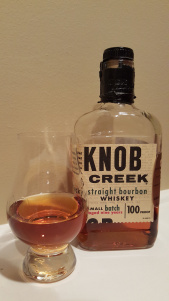 “I need some help, please,” our six-year-old commanded in frustration. She was trying to figure out how to use the fork and knife that the waitress had set before her to cut her pizza.
“I need some help, please,” our six-year-old commanded in frustration. She was trying to figure out how to use the fork and knife that the waitress had set before her to cut her pizza.
“Hold on a second, honey,” Jen sort of mumbled while she and I continued distributing pizza slices to the other three kids.
“One or two slices, Josh?” I asked.
“Two.”
Evelyn went into the fray alone. Chasing the pizza around the plate, “Momma,” she said again, “can you help me?”
“Harry, one or two?” I asked. “Evelyn, just wait a second.”
“Just one,” Harry decided.
Evelyn growled a little and then offered a frustrated snort, “But, I need help.”
No longer willing to wait, she set the silverware down beside her plate and jingled loudly for everyone in the restaurant, “Like a good neighbor, State Farm is there!”
Everyone at the table stopped and looked at the six-year-old. I think Madeline and Harrison observed to the left and right of her, almost expecting the genie-like insurance agent to appear and say, “Here, Evelyn, I’ve got you covered.”
I just froze. Jen’s hand went to her own mouth in order to hold back a possible burst into laughter.
“Honey,” I said breaking the stunned silence while restraining my own urge to chuckle. I intended to continue with, “I think you have to be a State Farm client for that to work.”
But having already crossed her arms in obvious disappointment, she interrupted, “That commercial lied. Those people lied.”
This is my first review of a bourbon. The only reason that it is happening is because at the moment I’m fresh out of untapped and unreviewed Scotch. But I wonder if I may be forced to begin venturing into this direction anyway. I haven’t traveled overseas in a while, which means that I’m limited to what’s available here in Michigan. And as the loyal followers will most likely have noticed, I’ve started doing more reviews of the bottom shelf stuff. But in the end, no matter what shelf I choose from, there are only so many editions to be had before I’ll need to start crossing state lines to acquire editions that are unavailable in Michigan.
I’m running out of options.
So then there’s Knob Creek. I gave it an honest run. I did. With that, I sure hope that there are other bourbons on the shelf that are better than this bottle of serous toxicant.
The label announces “superior taste and smoothness.” Evelyn is right. Companies lie.
First, the nose is harsh. As it begins, there is a promising hint of something like maple syrup, but then there is an overpowering billow of something pharmaceutic. I expected at least some bitterness, but there was just too much here to make this whisky a pleasurable sniff.
The palate is less troubling, although the medicative bite remains rather noticeably. Beyond that, I sensed that perhaps someone accidentally spilled what was left of a stale Coca-Cola into the batch. With a little water added, it becomes a sugary geist of root beer mixed with whatever that medicine is that you’re trying to sneak past the kid who refuses to drink it from the little plastic dosage cup.
The finish leaves the maple syrup, but it also leaves a little bit of acrid wood spice. Again, too much to be enjoyable.
Let’s just say that after the first sip, I went ahead and tried Evelyn’s trick, except I added a little to the incantation with the hopes that it would produce something other than an insurance agent.
But alas, as I called out, “Like a good neighbor, State Farm is there…with The Balvenie 17-year-old SherryOak in hand,” nothing happened.
Why? Because companies lie.


November 26, 2015
Review – Laphroaig, Cairdeas, Portwood (2013), (No Age Stated), 51.3%
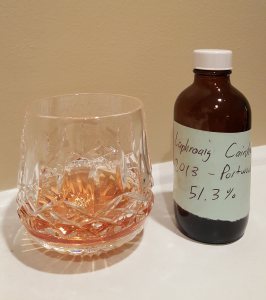 A few weeks ago I came across a meme that I thought spoke a near holy truth. It was set against one of those classic images from the 50s, one in which a mother dressed in a crisply ironed house dress was smiling down upon her young daughter. The tagline read: “My daughter asked me what it’s like to have kids, so I interrupted her every eleven seconds until she cried.”
A few weeks ago I came across a meme that I thought spoke a near holy truth. It was set against one of those classic images from the 50s, one in which a mother dressed in a crisply ironed house dress was smiling down upon her young daughter. The tagline read: “My daughter asked me what it’s like to have kids, so I interrupted her every eleven seconds until she cried.”
Bam. That one hit me like a tear-filled bus of interrupted children.
We experienced this unhallowed actuality tonight while attempting to watch a movie. Every few moments, one of our four would come down the stairs and ask us a question. Some of the questions related to promises Jen had made earlier in the evening – one in particular that sealed the fate of a pumpkin pie sitting on our kitchen counter and its sidekick can of whipped cream in the refrigerator.
Okay, I get those kinds of questions. I do. They wanted pie. But I guess what troubles me is that we tell them very clearly that they can have the pie when our movie is done, and so they come down the stairs every ten minutes or so asking if it’s time for pie; and because the movie isn’t one for little ones’ ears, Jen keeps pausing the movie.
But that’s not all. There are questions added here and there that nearly get my children tossed out a window.
Again, I understand the childhood impatience of wanting a pledged before-bed goodie, but what is it that stirs in the littlest of souls the need to come trotting down the stairs and ask a question like “Do you think it would be better to have twelve fingers instead of ten?” just after we told them to leave us alone until the movie is over? Can’t such a philosophic-biological question wait until the end credits?
I suppose each of the interruptions did give me an opportunity to consider another whisky sample sent to me by my friend, Nathan – the Laphroaig Cairdeas Portwood edition.
It wasn’t until the third or fourth movie intermission that I finally got up and poured myself a dram of this delightful little distraction.
A say delightful because unlike the sister edition — the Amontillado edition — the nose of this whisky is a bit more defined. The Amontillado is a muddle of smoke and soured salt, but this is a rather keen tangling of smoked raisins.
During another unwanted intermission, I took a moment to concentrate while savoring. The palate is a little like its sister in that the salt arrives on a plume. But then there are grapes. Because of the sweetness, I’d say concord, but I suppose really sweet reds might be an option.
The finish borders on long. This is true because it was still with me when I returned from chasing my six-year-old up the stairs and to her room. And I’ll add that throughout the chase, little meditation was needed. The wood spice was quite conspicuous.
You ask, “Did you like the movie?” Asking me that is kind of like asking me if I liked riding in your Porsche when during the entire ride you started and stopped it every ten feet. Yeah, I guess it was okay. The Laphroaig Cairdeas Portwood was certainly a worthy fill in for the gaps.


November 25, 2015
Review – Clynelish, 14 Years Old, 46%
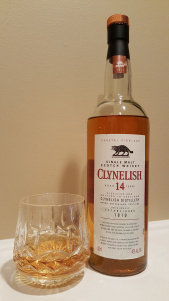 It’s been a busy year of funerals for my congregation.
It’s been a busy year of funerals for my congregation.
Here’s a seldom-revealed secret you should know about pastors – we prefer presiding at funerals more so than weddings.
Never would have guessed that, would you? Well, let me explain.
If you can for just a moment, consider the differences. In one, a wedding, the pastor is often considered as a prop – a mere accessory to the event. And so the two main figures – and no, not the bride and groom, but the bride and the mother of the bride – move from corner to corner, edge to edge as conjoined governesses ruling the royal provinces, even trying to impose their wills in a land that isn’t theirs to rule – the liturgy. Certainly I want the event to be memorable for the couple, and yes, if possible, I want the mother of the bride to vicariously achieve as many of her motherly desires as possible, but there’s a reason the Marriage liturgy stands as it does. God knows we need help keeping a better truth at the center of the event, and so the pastor and the liturgy, in a sense, are in place to lead us when we don’t want or even know we need to be led lest the marriage begin with the wrong point of origin and with an erroneous heading.
A funeral, now that is another story altogether.
At a funeral, people rarely want to lead. They hardly want to impose themselves. They don’t want to be the center of attention. They don’t even want to be there. The point of origin is unquestionable and the heading is clear. They want someone else, anyone else, to steer. They want anyone else to be the focus of the event. They want someone to take their hand and lead them to and through the next step. In fact, they want to be carried in the arms of someone much stronger than they will ever be, someone who can handle the disaster and offer a solution; someone who has been through it before and has a care, concern, and wisdom for revealing hope’s unquenchable glimmer in the midst of their darkened sadness.
At a funeral, a pastor isn’t an accessory and the liturgy isn’t an irritation. Both are needed.
Believe it or not, I have certain whiskies that I consider “after-marriage” drams and some that I only tip after a funeral. The “after-marriage” whiskies are the ones that serve as a reward of sorts for surviving the event. The “after-funeral” editions are the ones that are worthy of raising in memory of the deceased and in thankfulness for the privilege of being able to serve the surviving loved ones in their darkest hours.
The Clynelish 14 is an after-funeral edition.
The nose of this particular whisky is a cheerful whisper of honey and tangerines. The palate is the heartfelt and welcoming embrace of a sherry wine-kissed concoction of malt and tree nuts boiled to a steam and filling the room like incense. The medium finish is a warmed slice of buttercream and almond cake with a more swiftly fleeting peck of oak spice.
Pleasant. Enjoyable. Serene. Complete.
Of course I’m speaking of both the whisky and the one who’s gone before us into the joys of heaven.
To all others, slàinte mhath.





